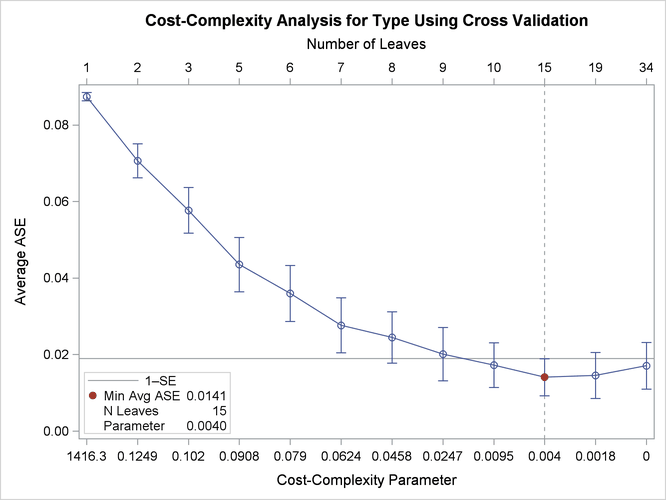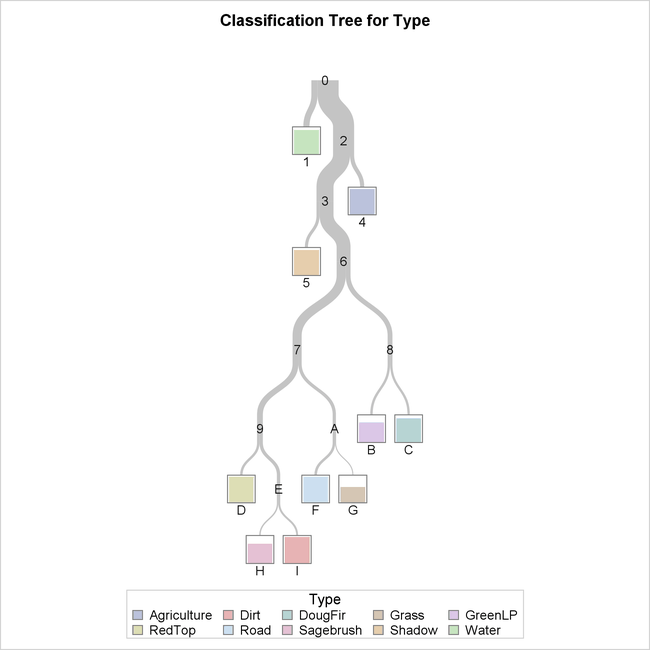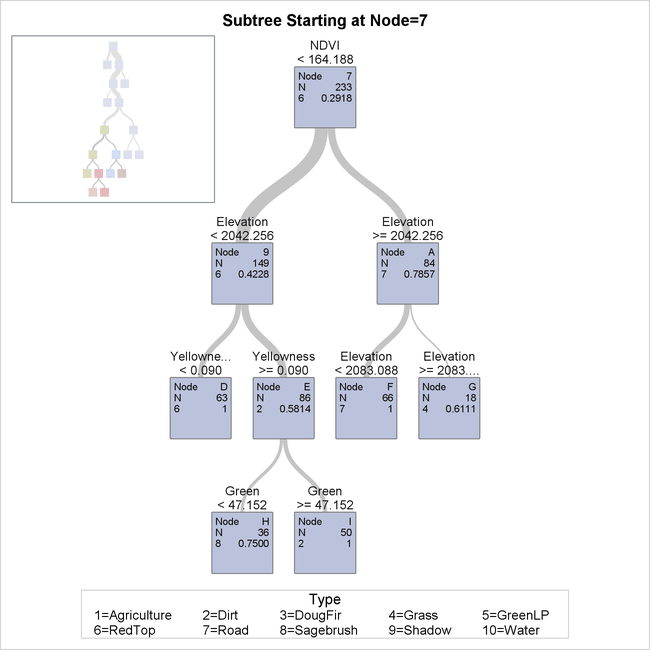The HPSPLIT Procedure
Example 61.2 Cost-Complexity Pruning with Cross Validation
In this example, data were collected to study the damage to pine forests from mountain pine beetle attacks in the Sawtooth National Recreation Area (SNRA) in Idaho (Cutler et al. 2003). (The data in this example were provided by Richard Cutler, Department of Mathematics and Statistics, Utah State University.) A classification tree is applied to classify various types of vegetation in the area based on data from satellite images. This classification can then be used to track how the pine beetle infestation is progressing through the forest. Data from 699 points in the SNRA are included in the sample.
This example creates a classification tree to predict the response variable Type, which contains the 10 vegetation classes represented in the data: Agriculture, Dirt, DougFir, Grass, GreenLP, RedTop, Road, Sagebrush, Shadow, and Water. The predictor variables include the following:
-
the spectral intensities on four bands of the satellite imagery:
Blue,Green,Red, andNearInfrared -
Elevation -
NDVI, a function ofRedandNearInfrared -
"Tasseled cap transformations" of the intensities on the four bands of imagery:
SoilBrightness,Greenness,Yellowness, andNoneSuch
A portion of the DATA step to generate the SNRA data set follows:
data snra;
length Type $ 11;
input X Y Blue Green Red NearInfrared Panchromatic SoilBrightness Greenness
Yellowness NoneSuch NDVI Elevation Type $ TypeCode ID;
datalines;
676523 4867524 26 31 20 106 57 89.075 73.07 -0.47 2.25 214 2157 Agriculture 1 1
676635 4867524 26 31 19 109 55 90.03 76.01 -0.31 1.59 217 2161 Agriculture 1 2
676771 4867504 26 31 19 108 59 89.561 75.13 -0.22 1.57 216 2165 Agriculture 1 3
676367 4867432 26 31 19 106 55 88.623 73.37 -0.04 1.53 216 2154 Agriculture 1 4
... more lines ...
667235 4891360 26 25 11 5 11 34.668 -11.97 7.51 -6.91 79 1978 Water 10 696
667143 4891348 27 28 13 6 12 38.102 -12.58 8.74 -5.8 80 1978 Water 10 697
667175 4891332 31 34 19 7 16 46.557 -15.92 9.81 -3.52 68 1978 Water 10 698
667215 4891332 32 36 22 9 18 50.417 -15.76 9.69 -1.78 74 1978 Water 10 699
;
The first step in the analysis is to run PROC HPSPLIT to identify the best subtree model:
ods graphics on;
proc hpsplit data=snra cvmethod=random(10) seed=123 intervalbins=500;
class Type;
grow gini;
model Type = Blue Green Red NearInfrared NDVI Elevation
SoilBrightness Greenness Yellowness NoneSuch;
prune costcomplexity;
run;
You grow the tree by using the Gini index criterion, specified in the GROW statement, to create splits. This is a relatively small data set, so in order to use all the data to train the model, you apply cross validation with 10 folds, as specified in the CVMETHOD= option, to the cost-complexity pruning for subtree selection. An alternative would be to partition the data into training and validation sets. The SEED= option ensures that results remain the same in each run of the procedure. Different seeds can produce different trees because the cross validation fold assignments vary. When you do not specify the SEED= option, the seed is assigned based on the time.
By default, PROC HPSPLIT creates a plot of the cross validated ASE at each complexity parameter value in the sequence, as displayed in Output 61.2.1.
Output 61.2.1: Plot of Cross Validated ASE by Cost-Complexity Pruning Parameter

The ends of the error bars correspond to the ASE plus or minus one standard error (SE) at each of the complexity pruning parameter values. A vertical reference line is drawn at the complexity parameter that has the lowest cross validated ASE, and the subtree of the corresponding size for that complexity parameter is selected as the final tree. In this case, the 15-leaf tree is selected as the final tree. The horizontal reference line represents the ASE plus one standard error for this complexity parameter.
Often, the 1-SE rule defined by Breiman et al. (1984) is applied when you are pruning via the cost-complexity method to potentially select a smaller tree that has only a slightly higher error rate than the minimum ASE. Selecting the smallest tree that has an ASE below the horizontal reference line is in effect implementing the 1-SE rule. Based on the line and the data that are shown in this plot, the subtree with 10 leaves would be selected according to this rule, so you can run PROC HPSPLIT again as follows to override the subtree that was automatically selected in the first run:
proc hpsplit data=snra plots=zoomedtree(node=7) seed=123 cvmodelfit
intervalbins=500;
class Type;
grow gini;
model Type = Blue Green Red NearInfrared NDVI Elevation
SoilBrightness Greenness Yellowness NoneSuch;
prune costcomplexity (leaves=10);
run;
This code includes specification of the LEAVES=10 option in the PRUNE statement to select this smaller subtree that performs almost equivalently to the subtree with 15 leaves from the earlier run. Specifying ZOOMEDTREE(NODE=7) in the PLOTS= option requests that the ODS graph ZoomedTreePlot displays the tree rooted at node 7 instead of at the root node. The CVMODELFIT option requests fit statistics for the final model by using cross validation as well as the cross validation confusion matrix.
Output 61.2.2 provides an overview of the final tree that has 10 leaves as requested.
Output 61.2.2: Diagram of 10-Leaf Tree Selected Using 1-SE Rule

It turns out that there is exactly one leaf in the classification tree that corresponds to each of the 10 vegetation classes;
this does not usually occur. The leaf color indicates the most frequently observed response among observations in that leaf,
which is then the predicted response for all observations in that leaf. The height of the bars in the nodes represents the
proportion of observations that have that particular response. For example, in node D, all observations have the value of
RedTop for the response variable Type, whereas in node G, it appears that slightly over half of the observations have the value Grass.
Output 61.2.3 shows more details about a portion of the final tree, including splitting variables and values.
Output 61.2.3: Detailed Diagram of 10-Leaf Tree

As requested, the detailed tree diagram is displayed for the portion of the tree rooted at node 7 so that you can view the
splits made at the bottom of the tree. You can see that several splits are made on the variable Elevation. The vegetation type most common in node G, whose observations have an elevation of at least 2083.0880, is Grass.
Confusion matrices are displayed in Output 61.2.4.
Output 61.2.4: Confusion Matrices for SNRA Data
| Confusion Matrices | ||||||||||||
|---|---|---|---|---|---|---|---|---|---|---|---|---|
| Actual | Predicted | Error Rate |
||||||||||
| Agriculture | Dirt | DougFir | Grass | GreenLP | RedTop | Road | Sagebrush | Shadow | Water | |||
| Model Based | Agriculture | 105 | 0 | 0 | 0 | 1 | 0 | 0 | 0 | 0 | 0 | 0.0094 |
| Dirt | 0 | 50 | 0 | 0 | 1 | 0 | 0 | 0 | 0 | 2 | 0.0566 | |
| DougFir | 0 | 0 | 55 | 0 | 11 | 0 | 0 | 0 | 0 | 0 | 0.1667 | |
| Grass | 1 | 0 | 0 | 11 | 1 | 0 | 0 | 2 | 0 | 0 | 0.2667 | |
| GreenLP | 0 | 0 | 5 | 0 | 49 | 0 | 0 | 1 | 0 | 0 | 0.1091 | |
| RedTop | 0 | 0 | 0 | 5 | 0 | 63 | 0 | 0 | 0 | 0 | 0.0735 | |
| Road | 0 | 0 | 0 | 0 | 0 | 0 | 66 | 0 | 0 | 2 | 0.0294 | |
| Sagebrush | 0 | 0 | 0 | 2 | 0 | 0 | 0 | 27 | 0 | 0 | 0.0690 | |
| Shadow | 0 | 0 | 0 | 0 | 0 | 0 | 0 | 2 | 76 | 6 | 0.0952 | |
| Water | 0 | 0 | 0 | 0 | 0 | 0 | 0 | 4 | 3 | 148 | 0.0452 | |
| Cross Validation | Agriculture | 104 | 0 | 0 | 0 | 2 | 0 | 0 | 0 | 0 | 0 | 0.0189 |
| Dirt | 0 | 49 | 0 | 0 | 1 | 0 | 0 | 1 | 0 | 2 | 0.0755 | |
| DougFir | 1 | 0 | 56 | 0 | 9 | 0 | 0 | 0 | 0 | 0 | 0.1515 | |
| Grass | 2 | 0 | 0 | 10 | 0 | 1 | 0 | 2 | 0 | 0 | 0.3333 | |
| GreenLP | 1 | 0 | 14 | 0 | 38 | 0 | 0 | 1 | 1 | 0 | 0.3091 | |
| RedTop | 0 | 0 | 0 | 4 | 1 | 61 | 0 | 1 | 1 | 0 | 0.1029 | |
| Road | 0 | 0 | 0 | 0 | 0 | 3 | 63 | 0 | 0 | 2 | 0.0735 | |
| Sagebrush | 0 | 1 | 0 | 2 | 0 | 0 | 0 | 26 | 0 | 0 | 0.1034 | |
| Shadow | 0 | 0 | 0 | 0 | 0 | 0 | 0 | 4 | 74 | 6 | 0.1190 | |
| Water | 0 | 0 | 0 | 0 | 0 | 2 | 0 | 2 | 3 | 148 | 0.0452 | |
This table contains two matrices—one for the training data that uses the final tree and one that uses the cross validation
folds—requested by the CVMODELFIT
option in the PROC HPSPLIT
statement. The values on the diagonal of each confusion matrix are the number of observations that are correctly classified
for each of the 10 vegetation types. For the model-based matrix, you can see that the only nonzero value in the RedTop column is in the RedTop row. This is consistent with what is shown in Output 61.2.2, where the bar in node D with a predicted response of RedTop is the full height of the box representing the leaf, indicating that all observations on that leaf are correctly classified.
You can also see from the matrix that the DougFir and GreenLP vegetation types are hard to distinguish; 11 of the 66 observations that have an actual response of DougFir are incorrectly assigned the response of GreenLP, corresponding to the 0.1667 error rate reported for DougFir.
Fit statistics are shown in Output 61.2.5.
Output 61.2.5: Fit Statistics for SNRA Data
You can see from this table that the subtree with 10 leaves fits the training data very accurately, with 93% of the observations classified correctly. Because no validation data are present in this analysis, you get a better indication of how well the model fits and will generalize to new data by looking at the cross validation statistics, also requested by the CVMODELFIT option, that are included in the table. The misclassification rate that is averaged across the 10 folds is higher than the training misclassification rate for the final tree, suggesting that this model is slightly overfitting the training data.
